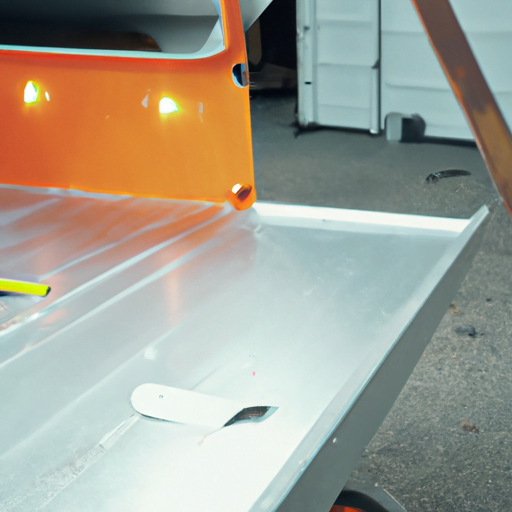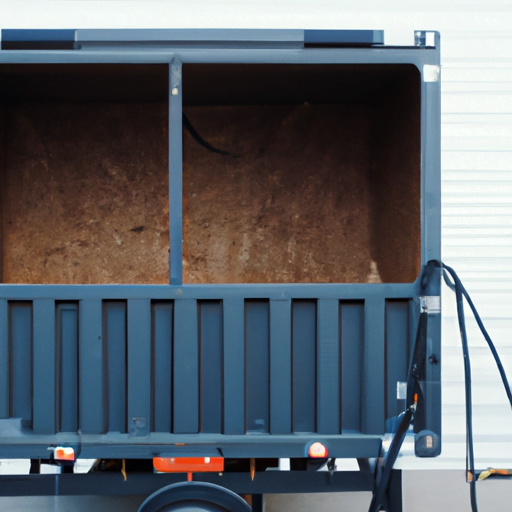-
Table of Contents
Introduction

“Repairing Your Dump Trailer: DIY Tips” is an insightful guide designed to empower individuals with the knowledge and skills they need to perform basic maintenance and repairs on their dump trailers. This tutorial will cover various aspects of dump trailer repair, including parts replacement, troubleshooting common issues, preventative measures for long-term durability and safety checks. With significant focus on a do-it-yourself approach, this guide aims to save its readers time and money while promoting self-sufficiency among dump trailer owners.
Mastering DIY: Step-by-Step Guide on How to Repair Your Dump Trailer
If you’re the proud owner of a dump trailer, chances are you rely heavily on it for your hauling needs. Like all equipment, however, there are times when it will require some much-needed repairs. But before you send it to an expensive mechanic shop or at the very least start considering buying a new one – stop right there! You might just be capable of fixing that problem yourself and saving money in the process.
Before starting any repair work, safety should always come first. So make sure to locate and follow specific manufacturer’s guidelines regarding maintenance and repairs—these may also help with troubleshooting whatever issue your trailer has.
The most common issues usually arise from hydraulics systems: like slow operation or not operating at all. If this is happening to you, don’t worry—there’s likely a straightforward solution involving checking and topping up hydraulic fluid levels or pushing out trapped air bubbles in the hose system via bleeding methods; both tasks which can be done relatively easily by anyone handy enough around tools.
But let’s take things step by step here. Before anything else, confirm whether indeed the hydraulics system is problematic — plug-in power leads then activate remote control while observing relevant operations (like raising/uplifting). A functioning pump would mean yes—the trouble lies therein; if not so far as we’re concerned—it’s an electrical issue instead.
In case of electrical problems such as failure to charge battery-operated systems or malfunctioning lights venturing DIY solutions might be daunting but often they boil down just tracing wires looking-out for frayed ends/loose connectors needing replacement/rescrewing respectively moreover routinely cleaning plugs/sockets ensures improved connectivity thus averting future similar headaches beforehand too incidentally!
Now back onto our hydraulics – after confirming above diagnosis next step typically entails physically inspecting hoses/pipes detect potential leaks avoid ignoring even small ones because these could lead more substantial damaging effects over time replace necessary remember using correct-size fittings tighten adequately don’t overtighten risk cracking the hose.
Speaking of things cracking, ever notice cracks or bends on your trailer’s frame? That’s one more common problem. Your first instinct may be to weld it back together—please resist temptation! While welding might seem like a quick fix, it can weaken steel frames and cause more damage down the line. Instead, drill stop holes at each end of a crack to prevent it from spreading further and use patches for reinforcement where necessary.
Roller problems could be another nuisance but fortunately – these are rather simple affairs involving either loosening-up stuck ones using penetrating oil then hand-spinning them back motion alternatively if they’re visibly damaged beyond repair (like warped/blunt rollers) consider replacing with new parts entirely always ensuring compatibility specifications though remember no rule says you have to tackle all this alone calling up couple friends assist holding heavy-duty components place while working can accelerate process significantly besides making entire task bit fun too!
In conclusion conducting DIY dump trailer repairs isn’t rocket science: armed patience right tools mindfulness safety due respect manufacturer’s instructions virtually anyone achieve success endeavor relatable mantra worth repeating throughout journey would ‘addressing small developments early-on prevents large catastrophes later’ essentially projecting habit proactive regular maintenance as sound investment towards extending dump-trailer’s service-life ultimately saving considerable money time effort long-run who knows just beginning many exciting hands-on projects embark upon industrial world after mastering one!
Essential DIY Techniques for Fixing Your Damaged Dump Trailer
There’s nothing quite like the satisfaction of accomplishing a DIY project, especially when it comes to repairing your own dump trailer. Not only does it save you some hard-earned cash, but it also gives you an opportunity to familiarize yourself with the workings of your machine. The good news is, anybody can fix their dump trailer with enough patience and follow-through; you don’t need to be a skilled mechanic or even particularly handy.
Before we begin delving into the essential repair techniques, one critical component everyone should remember is safety. Working on heavy machinery represents its share of risks—get in contact with the wrong parts and serious injury could occur. With that said, always make sure your workspace is clear from unnecessary items or clutter which may pose danger during repairs.
As for tools needed in fixing damaged trailers? You’d probably already have these at home: wrenches (for tightening bolts), D-clamps (keep things secured while working), pry bars (used removing nails and prying loose boards), hammers (drive nails back into place), plus power drills and jigsaws should more serious work be required.
After ensuring safety measures are taken care of and having gathered all necessary tools let’s get right into what specific issues often come up with dump trailers,and how they can be repaired manually.
First off, axle problems are quite common among this type of trailer. If wear becomes apparent over time—usually signaled by uneven tire wear—it’s high time for replacement parts instead continuous band-aid fixes same issue reappearing down line Again DIY doesn’t mean doing everything alone so if replace entire axle system seems too daunting task enlist help professional mechanic prevent further damage But say we’re faced smaller scale problem such as pinched wires or disconnected brake cable under greasy conditions fear not as swift intervention rectify
In case dealing pinched brake wire look section damage straighten as much possible Next strip insulation both sides using wire stripper connect them back together solder joint finish off with electrical tape to insulate it Again don’t forget remember safety precautions dealing electricity.
If disconnected brake cable appears be culprit attempt reconnect its proper location normally involves going under trailer and finding spot where fell off Make sure before reattachment adjust tension ensure brakes are working properly
Certainly, even dump trailers aren’t immune occasional exterior damage. So say you notice holes in the floor or sidewalls thanks excessive weight materials have been carrying Remember though patching such requires careful attention avoid further corrosion already weakened area
Start by clearing away any loose particles around hole Next grind surrounding metals bare then cut piece metal (of same type as your trailer’s) fit over damaged area Following that weld this onto existing frame but if welding isn’t an option extreme-bond adhesive work too Lastly paint patched section with rust-resistant coating for added protection.
In conclusion, taking the time and effort to understand the workings of your own dump trailer can save valuable resources while providing a sense of accomplishment. After all, these heavy-duty machines are investments made towards efficient workload management—and timely repairs could significantly extend their service life. But most importantly, always prioritize safety when conducting DIY projects.
Getting Hands-On: Easy Steps to Successfully Repair Your Dump Trailer at Home
Knowing how to repair your dump trailer is a practical and valuable skill that can save you time and money. It’s great news for the dedicated DIY enthusiasts among us, as there are quite a few simple repairs that you handle, right in the comfort of your own garage or shed.
Let’s start with one of the most common problems – leaks in the hydraulic system. If your dump trailer isn’t lifting as it should, there could be a leak in one of its components – usually identifiable by oil spots underneath after use. For this kind of problem, start by checking all connections – from cylinders and valves to pumps and hoses – tightening any loose fixtures along the way. Then clean up any residual oil before using again so future leaks will be easier to spot.
Next on our list: fixing bent tailgate latches—a fairly common issue among heavy-duty users who often deal with large loads. Most latch issues result from strained metal warping due to overloading or accidental collisions during backing up maneuvers. To correct this damage yourself, remove the latch assembly completely before gently hammering out any bends until they’re sufficiently straightened—ensuring functionality has been restored prior moving onto reassembly.
A third typical issue involves difficulty closing or opening your dump trailer gate due to misaligned hinges—an unfortunate consequence of weight distribution inconsistencies during unloading processes. Thankfully though, such hinge woes are easily rectified via thorough inspecting followed by adjusting each unit individually (using wrenches) until alignment perfection achieved—one bit at a time!
Now if you’ve noticed excessive tire wear on one side more than other suggesting potential axle issues might be causing uneven road contact stresses require addressing accordingly post haste! Firstly determine which particular type your model utilizes; solid axles require replacement entirely whereas torsion types allow separate rubber cartridge change-outs saving cost overall generally speaking both jobs manageable enough solo albeit needing copious amounts patience doing correctly avoiding further complications down line sure worth effort considering savings made!
But be warned, even with the most meticulous maintenance routine, there comes a time when parts wear out and replacements are inevitable. In cases where hydraulic pumps or cylinders have reached their lifespan limit, it’s recommended to source high-quality replacements as soon as possible. Preventative changes like these can stave off any potential work stoppages due to unexpected machinery failures.
Lastly but certainly not least significant is trailer lighting systems; they’re absolutely essential for both safety and legal compliance when using public roads transporting loads from A to B! Problems typically arise from faulty wiring connections or burned-out bulbs—both of which are super easy fixes involving either soldering new wires in place (after disconnecting power sources!) then testing for operational success before wrapping everything up again securely against inclement weather hindrances looking forward future trips worry-free.
So there you have it: an overview on how you can repair common issues that might crop up with your dump trailer right at home. The key lies in possessing both patience and a willingness to learn—a combination that will allow you not only identify problems swiftly but also remedy them effectively ensuring many more years reliable service spent together productively fruitful companion indeed!
Q&A
1. Question: What are the initial steps in repairing a dump trailer?
Answer: The initial steps involve diagnosing the issue with your dump trailer. It could be a hydraulic system failure, structural damage, or electrical problems. Once you’ve identified the issue, gather all necessary tools and materials for repair – this might include wrenches for tightening loose parts, replacement hydraulic fluid for leaks, or wiring kits for electrical issues.
2. Question: How do I fix a leaking hydraulic system on my dump trailer?
Answer: Fixing a leak in the hydraulic system usually involves sealing off any visible cracks within the tubing using an appropriate sealant material like rubber cement or epoxy resin. If tubes themselves are damaged beyond repair, they may need to be completely replaced.
3. Question: What should I do if there is structural damage to my dump trailer?
Answer: Structural damages like bends or breaks in the metal require more intensive repairs that often involve welding. However, small dents can sometimes be hammered out. Always remember safety precautions such as disconnecting power sources before beginning work and using protective gear like gloves and helmets during the repair process.
Conclusion
In conclusion, repairing a dump trailer can be done by oneself with some DIY tips. These include conducting regular inspections to identify any issues early on; repairing structural defects such as cracks, bends or broken welds; maintaining the hydraulic system to ensure it doesn’t malfunction; checking and replacing worn out tires; examining and fixing electrical problems like faulty lights or wiring issues. Also, rust prevention is crucial for extending the life of your dump trailer. By following these guidelines, one can keep their dump trailer in good working condition without relying on professional services every time something goes wrong.

